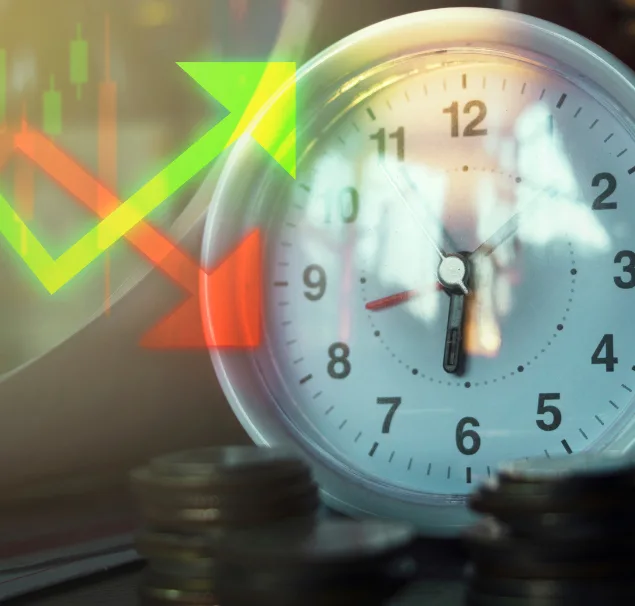
Time Frame To Trade
In the world of trading, the concept of time frames is foundational, influencing everything from the analysis to the execution of trades. Time frames in trading refer to the duration over which market movements are analyzed and trades are planned and executed. These can range from extremely short periods, such as minutes within a single trading day, to much longer periods spanning weeks, months, or even years.
Selecting the right time frame is not just a matter of personal preference; it’s a strategic decision that aligns with a trader’s goals, risk tolerance, and trading style. Whether you’re a day trader reacting to minute-by-minute changes, a swing trader focusing on days to weeks, or a position trader looking at the long term, the chosen time frame significantly impacts your trading approach and potential outcomes.

Understanding Time Frame to trade
Time frames in trading are categorized broadly into three types: intraday, intermediate, and long term.
Intraday time frames include the 1-minute, 5-minute, 15-minute, and 1-hour charts, offering a granular view of market movements. These are preferred by traders who operate within the confines of a single trading day, aiming to capitalize on small price movements.
Daily and weekly charts fall into the intermediate category, suited for traders with a medium-term outlook. These time frames provide a balanced view, capturing broader trends without the noise seen in shorter time frames.
Monthly charts represent the long term, revealing overarching trends and cycles in the market. These are often used by position traders who are prepared to hold trades over months or years, looking beyond the short-term volatility to the larger price movements.
Each time frame offers unique insights, with shorter durations providing more signals and opportunities for profit but also requiring quick decision-making and exposing traders to higher risk. Conversely, longer time frames offer more stability and are less demanding in terms of constant market monitoring but require patience and a larger capital buffer to withstand market fluctuations.

The Importance of Time Frame Selection
The choice of time frame is crucial for aligning your trading strategy with your market view and risk profile. A well-chosen time frame enhances the effectiveness of your analysis, helping to identify clear trends and signals amid market “noise”. It also dictates your approach to risk management, influencing everything from the size of your positions to the placement of stop-loss orders.
Selecting the right time frame requires a thorough understanding of your own trading style and objectives. Are you looking to make quick profits from small price movements, or are you more interested in capturing larger trends? How much time can you dedicate to monitoring the markets? Your answers to these questions will guide your choice of time frame, shaping your trading experience and influencing your chances of success.
In the next sections, we’ll explore the advantages and disadvantages of different time frames, offering insights into how to determine the best fit for your trading strategy and lifestyle.
Advantages and Disadvantages of Different Time Frame to Trade
Intraday Trading Time Frames
Advantages:
Offers numerous trading opportunities within a day; ideal for quick, short-term profits.
Disadvantages:
Requires constant market monitoring; high stress and potential for rapid losses due to volatility.
Daily Time Frame
Advantages:
Provides a clearer view of market trends; suitable for traders who cannot monitor the markets every moment.
Disadvantages:
Fewer trading signals compared to intraday; requires patience and a larger potential stop-loss margin.
Weekly and Monthly Time Frames
Advantages:
Best for identifying long-term trends and patterns; lower transaction costs due to fewer trades.
Disadvantages:
Requires significant capital to withstand market swings; not suitable for those seeking quick returns.
Choosing the Best Time Frame To Trade
Assessment of Trading Style and Goals
Whether you're a scalper, day trader, swing trader, or position trader.
Risk Tolerance
Understanding your capacity to endure market fluctuations and the impact of various time frames on risk.
Availability
How much time you can dedicate to trading and market analysis each day. Technical Analysis Preference: Whether you rely on technical indicators that might perform differently across time frames.
Time Frame Strategy Alignment
Scalping and Day Trading
Best suited for short-term intraday time frames where quick decision-making is crucial.
Swing Trading
Often relies on daily to weekly charts to capture significant market moves over several days or weeks.
Position Trading
Utilizes weekly to monthly charts to understand the broader market trend and make long-term investment decisions.
Risk Management Across Time Frames
Setting Stop-Loss Orders
Importance varies with time frame; tighter for short-term, wider for long-term trading.
Position Sizing
Adjusting trade size according to the volatility and expected holding period associated with different time frames.
Conclusion
Choosing the right time frame is pivotal to aligning your trading strategy with your market outlook and risk management profile. By carefully considering your trading style, goals, and time availability, you can select a time frame that enhances your trading effectiveness, maximizes profits, and minimizes risks. Remember, the best time frame for trading is the one that resonates with your personal trading philosophy and lifestyle.
